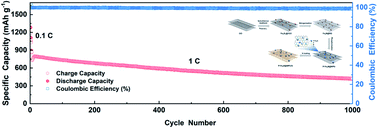Phosphorus-modified Fe4N@N,P co-doped graphene as an efficient sulfur host for high-performance lithium–sulfur batteries†
Abstract
Lithium–sulfur batteries have attracted increasing attention in the field of energy storage due to their advantages of high specific energy and energy density. However, there are still many difficulties in the practical application of lithium–sulfur batteries, such as large volume expansion of sulfur and shuttle effect of polysulfides, which led to rapid capacity attenuation and poor cycling performance. To address these problems, herein, nanosized phosphorus-modified Fe4N supported by nitrogen, phosphorus co-doped graphene nanosheets (P-Fe4N@NPG) has been synthesized by a simple solvothermal method combined with subsequent nitriding and phosphating calcination, and then used as a sulfur host for lithium–sulfur batteries. Benefiting from the high electrical conductivity, multiple composition and unique structure, the obtained P-Fe4N@NPG/S cathode exhibits excellent electrochemical performances: the cathode presents a high initial specific capacity of 1386.1 mA h g−1 at 0.1C, distinct cycling performance (417.4 mA h g−1 at 1C after 1000 cycles) and excellent rate performance with a sulfur loading of 73 wt%. Even if the sulfur loading increases as high as 3.52 and 5.65 mg cm−2, the cathode still displays an excellent rate performance and outstanding areal capacity of 6.03 mA h cm−2, respectively. These results indicate that our design of P-Fe4N@NPG is a great development in the application of sulfur hosts for lithium–sulfur batteries.



 Please wait while we load your content...
Please wait while we load your content...